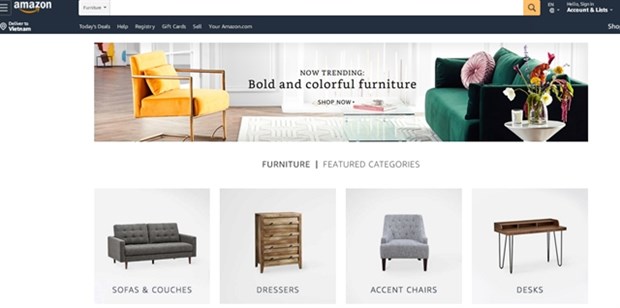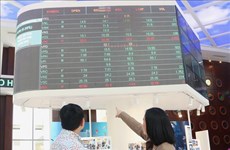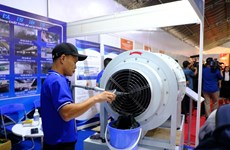Wood industry to promote online sales to find new markets
Domestic wood processing enterprises are urged to use more online commercial channels to find new markets and customers, especially during the COVID-19 epidemic.
 Illustrative image (Photo: Amazon)
Illustrative image (Photo: Amazon) Hanoi (VNS/VNA) - Domestic wood processing enterprises are urged to
use more online commercial channels to find new markets and customers,
especially during the COVID-19 epidemic.
Tran Viet Tien, a leader of the Handicraft and Wood Industry Association of Ho Chi Minh City (HAWA), said: “With lots of new designs and models for their products, many local furniture firms still cannot find orders due to the current epidemic.”
Dzung Nguyen, CEO of HMD Information Technology, a member of California-based Yes4All firm said: “Vietnamese furniture shipments will be available on Yes4all’s sale channels in May at the latest."
The CEO, who said Yes4All is active on Amazon and Ebay, declared that such shipments result from a long journey of negotiation and preparation between Yes4all and NCT, a local furniture brand specialising in exporting to European markets.
With more than 10 years of experience in selling sporting goods online, Yes4All saw an opportunity in selling Southeast Asian furniture products to US customers.
The CEO said: "Like kitchen utensils, furniture items can be sold online,” adding it was time for furniture firms to join online distribution channels.
Dzung said furniture chains has begun to list products on e-commerce sites like Etsy, Amazon and Wayfair.
At the same time, Nguyen Ngoc Dung, Vice President of Vietnam E-Commerce Association (Vecom), said that e-commerce is the best solution for the wood processing industry, as the COVID-19 epidemic is "blocking" the industry to customers in China and also halting a lot of trade fairs around the world. Concerned about infection, many shoppers are avoiding traditional furniture showrooms.
As a result, Dung said: "Going O2O (online to offline) will be the fastest way to adapt to current fluctuations."
Access to cross-border shoppers
O2O was a retail business model that combines both online marketing and introduction of products to attract customers to buy them at the stores (offline).
According to the experts, IKEA's "interior tycoon" is a good example of the O2O model when it has applied virtual reality to the sale of furniture products.
Acknowledging the benefits of O2O, HAWA’s Tien mentioned one difficulty: “Applying the O2O model is not simple, as it requires firms to spend more on human resources and technology.”
For example, Tien said: “The 3D and VR technology that helps buyers see and experience the products is costly.”
More importantly, Tien said: “No matter how much they spent on online channels, the businesses must never forget their offline systems, like showrooms and workshops.”
“At the end of the day, the most important factor is the quality of the products and the real experience of the users,” said Tien.
Wood chips are Vietnam’s main export products to China, with a turnover of more than 972 million USD in 2019, or 79.2 percent of total export turnover of wood and timber products. Meanwhile, Vietnam imported wooden planks worth 400 million USD.
The Government has set a target of 20 billion USD in wood exports by 2025 – nearly double the current turnover. To achieve this goal, it will require fundamental changes in both business strategies in each enterprise and the development strategy of the whole industry.
The industry meanwhile is also calling on the Government’s support in institutional and policy environment to create the most favourable conditions for their business activities. In addition, the Government also needs to create a channel to promote Vietnam’s clean wood and timber brand./.
Tran Viet Tien, a leader of the Handicraft and Wood Industry Association of Ho Chi Minh City (HAWA), said: “With lots of new designs and models for their products, many local furniture firms still cannot find orders due to the current epidemic.”
Dzung Nguyen, CEO of HMD Information Technology, a member of California-based Yes4All firm said: “Vietnamese furniture shipments will be available on Yes4all’s sale channels in May at the latest."
The CEO, who said Yes4All is active on Amazon and Ebay, declared that such shipments result from a long journey of negotiation and preparation between Yes4all and NCT, a local furniture brand specialising in exporting to European markets.
With more than 10 years of experience in selling sporting goods online, Yes4All saw an opportunity in selling Southeast Asian furniture products to US customers.
The CEO said: "Like kitchen utensils, furniture items can be sold online,” adding it was time for furniture firms to join online distribution channels.
Dzung said furniture chains has begun to list products on e-commerce sites like Etsy, Amazon and Wayfair.
At the same time, Nguyen Ngoc Dung, Vice President of Vietnam E-Commerce Association (Vecom), said that e-commerce is the best solution for the wood processing industry, as the COVID-19 epidemic is "blocking" the industry to customers in China and also halting a lot of trade fairs around the world. Concerned about infection, many shoppers are avoiding traditional furniture showrooms.
As a result, Dung said: "Going O2O (online to offline) will be the fastest way to adapt to current fluctuations."
Access to cross-border shoppers
O2O was a retail business model that combines both online marketing and introduction of products to attract customers to buy them at the stores (offline).
According to the experts, IKEA's "interior tycoon" is a good example of the O2O model when it has applied virtual reality to the sale of furniture products.
Acknowledging the benefits of O2O, HAWA’s Tien mentioned one difficulty: “Applying the O2O model is not simple, as it requires firms to spend more on human resources and technology.”
For example, Tien said: “The 3D and VR technology that helps buyers see and experience the products is costly.”
More importantly, Tien said: “No matter how much they spent on online channels, the businesses must never forget their offline systems, like showrooms and workshops.”
“At the end of the day, the most important factor is the quality of the products and the real experience of the users,” said Tien.
Wood chips are Vietnam’s main export products to China, with a turnover of more than 972 million USD in 2019, or 79.2 percent of total export turnover of wood and timber products. Meanwhile, Vietnam imported wooden planks worth 400 million USD.
The Government has set a target of 20 billion USD in wood exports by 2025 – nearly double the current turnover. To achieve this goal, it will require fundamental changes in both business strategies in each enterprise and the development strategy of the whole industry.
The industry meanwhile is also calling on the Government’s support in institutional and policy environment to create the most favourable conditions for their business activities. In addition, the Government also needs to create a channel to promote Vietnam’s clean wood and timber brand./.













